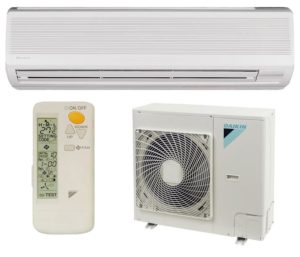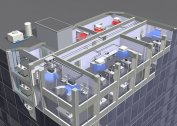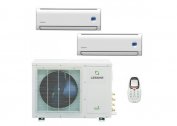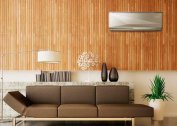Conventional air conditioning technology can maintain a set room temperature, but cannot control other environmental parameters. Split system with the function of humidification and air purification solves the problem in a complex. Additional features increase the cost of air conditioning, but provide a comfortable environment in everyday life.
The use of split systems with humidification and air purification
The work of climate technology changes the air in the room. It's about temperature and humidity. During operation, the air conditioner evaporates water, and condensation occurs when warm air and cold heat exchanger come in contact. The average amount of moisture discharged per day into the drainage is up to 10 liters. Especially the problem is relevant in the winter, when the central heating is turned on.
The normal level of humidity is 40-60%, when it falls, the well-being of people worsens.
Drying of the mucous membrane provokes the development of viruses. Not only people suffer from a lack of moisture, but also plants and furniture.
The problem is solved by installing a household humidifier. Minus - the new device will require maintenance costs, a place to place. Buying a split system with humidification and air purification will provide favorable indicators for all important parameters. The technique has temperature and humidity sensors. Air conditioners with humidification function are installed in apartments, private houses, offices, medical facilities, hotels.
Air conditioners controlled by air conditioners
The main parameters of indoor air, affecting the well-being of a person: temperature, humidity, cleanliness. The initial task of climate technology is to provide coolness in the heat and heat the room in the off-season. Circulation of the flow in a confined space leads to a deterioration in its sanitary and hygienic characteristics.
The expansion of equipment capabilities allows air conditioning to be humidified. Multi-stage filtration makes it fresh and enjoyable.
One of the ways to protect consumers is to cover the nodes of the indoor unit of split systems with an antibacterial composition. It processes the fan, heat exchanger and remote control.
The principle of humidification
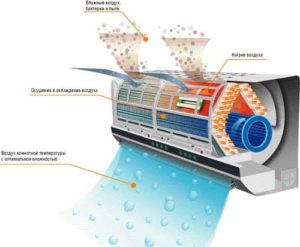 Among the additional functions of climate technology there is an option to increase relative humidity. Air conditioning humidification occurs in three ways:
Among the additional functions of climate technology there is an option to increase relative humidity. Air conditioning humidification occurs in three ways:
- Split system equipment with a steam generator. When water is heated by two electrodes, steam is released that is mixed with the incoming air.
- The equipment is equipped with an ultrasonic humidifier. In a special chamber under the influence of high-frequency oscillations, a fine suspension is formed from water. Dry air passes through the fog and is evenly saturated with moisture. The water supply in the system is replenished due to condensate draining into the drainage system. Flexible and smooth adjustment of functioning is carried out due to the built-in hydrostat.
- Use of a humidifying element integrated in the outdoor unit. The system does not require a separate water tank, which must be periodically replenished. Air entering the outdoor unit of the split system is passed through a zeolite cassette. Hygroscopic porous material collects condensate. With a constant rotation of the cartridge, moisture is transferred to the heating section. Warm air is saturated with drops of water. The flow of fluid depends on the performance of the device.
An air conditioner with a humidifier distributes it evenly throughout the room. Productivity of the equipment is 400-600 ml / hour.
Daikin research has shown that when humidity increases by 30%, the temperature seems to be 1 ° higher.
Air cleaning principle
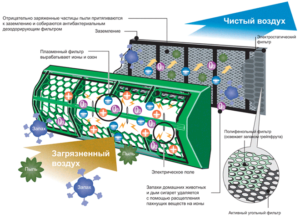 One of the main characteristics of HVAC equipment is the quality of air purification in the premises served. Devices are equipped with general and special filtering systems. They are divided into two main categories: rough and fine. Manufacturers of HVAC equipment offer equipment with sets of different types of filters. Their purpose ranges from the simple capture of dust, wool, dirt to the destruction of odors, bacteria and viruses.
One of the main characteristics of HVAC equipment is the quality of air purification in the premises served. Devices are equipped with general and special filtering systems. They are divided into two main categories: rough and fine. Manufacturers of HVAC equipment offer equipment with sets of different types of filters. Their purpose ranges from the simple capture of dust, wool, dirt to the destruction of odors, bacteria and viruses.
The main types of filters
Behind the air intake grille of each air conditioner there is a barrier for large debris of 2 microns in size. This is a coarse filter, which is a fine-mesh plastic mesh. It protects the mechanism from contamination, reducing the life of the equipment. The plastic insert is reusable, it is taken out once or twice a month, washed, dried and inserted into place. Some models of air conditioners have sensors that indicate contamination of the protective mesh.
Fine filters are able to cope with many options for home pollutants:
- dust, pet hair, skin particles;
- unpleasant odors;
- plant pollen;
- viruses, bacteria and other microorganisms;
- toxic discharge.
The installation of several types of filters improves the quality of air purification, but affects the price of equipment.
Before buying an air conditioner, they choose the optimal set of functions necessary to ensure comfortable conditions in the room.
Absorption filters:
- Coal (carbon) - the active ingredient is activated carbon, which traps unpleasant odors and harmful particles. Requires periodic replacement.
- HEPA filter - translation of the abbreviation means "highly efficient particle retention." The protective barrier is formed by a system of fibers with a complex shape. The material retains particles smaller than 0.1 microns. Due to the effect of engagement and inertia, it is suitable for mechanically capturing dust with a diameter of 0.4 microns. When air moves, small and medium particles cling to the fibers.
Antibacterial filters are made by applying the active substance to a polymer base. The components that neutralize bacteria and viruses are natural substances: catechin (extract from tea), wasabi. In budget models, the base is saturated with vitamin C.
 Photocatalytic - devices that break down hazardous pollution into harmless substances. They consist of an ultraviolet lamp and a base coated with titanium oxide. Radiation kills microorganisms, and titanium is a catalyst. The filter is maintenance free.
Photocatalytic - devices that break down hazardous pollution into harmless substances. They consist of an ultraviolet lamp and a base coated with titanium oxide. Radiation kills microorganisms, and titanium is a catalyst. The filter is maintenance free.
Plasma - A common filter option in models of modern air conditioners. It acts on the principle of ionization. Low-temperature plasma destroys allergens and harmful particles that settle on the surface of special plates. Devices quickly clean the air flow of odors.
Electrostatic - the device creates an electromagnetic field that charges particles of dirt. Having received a positive charge, they settle on plates with the opposite value. Filters trap substances with a size of 0.01 microns. They are washed periodically with water.
Enzyme biofilter contains active substances that kill bacteria. Over time, the number of enzymes decreases, you need to change the filter.
The first manufacturers to install a multi-stage air purification system were Samsung and Panasonic.
Modern models of air conditioners Daikin, LG, Mitsubishi are equipped with plasma filters for antibacterial treatment of rooms. They trap odors, allergens, tiny particulate matter from exhaust fumes and cigarette smoke.After a multi-stage cleaning inside the thin filters, air masses are fed into the room. Their parameters are completely safe.
In climate systems, the filtering and humidification functions complement each other. The air stream initially cleans the particles of dust and allergens. Then it is passed through a humidification section (evaporator, misty suspension). At the final stage, the humidified cold stream passes through a fine filter.
The Japanese company Daikin is an innovator in air conditioning systems. She was the first to start mass production of air conditioners with humidification function.
